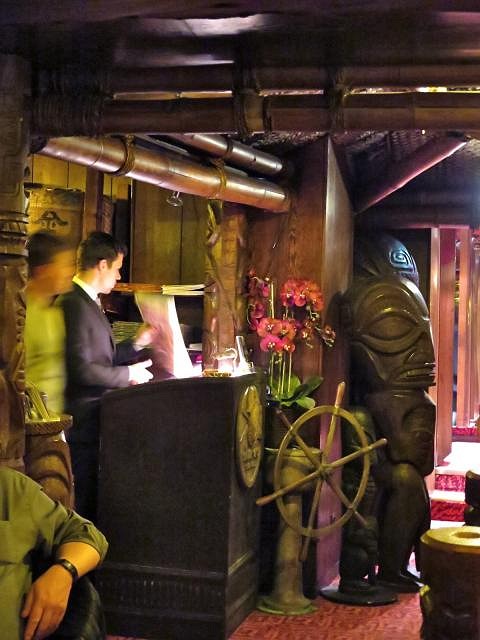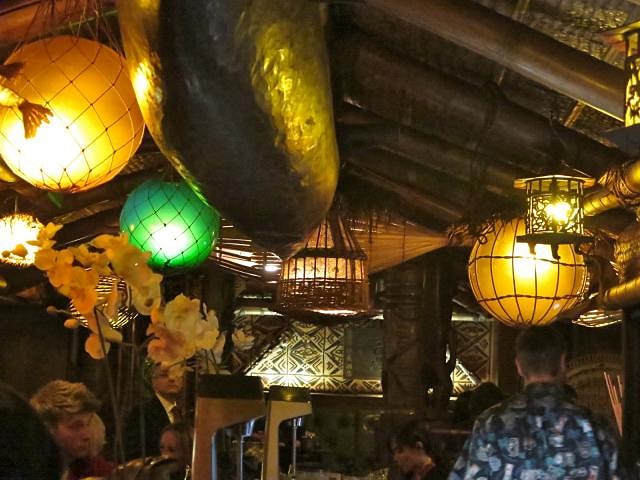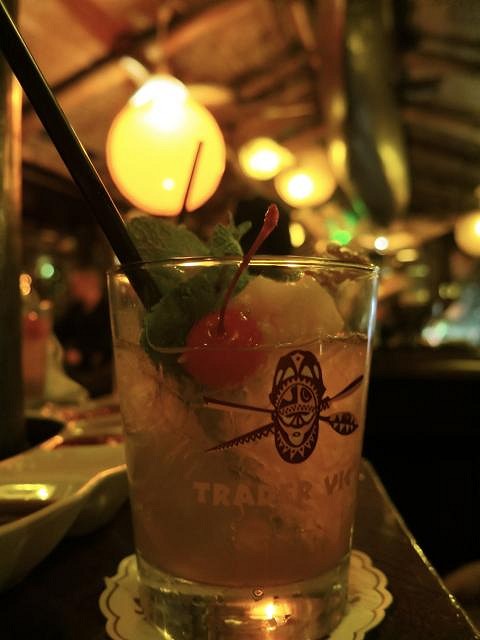Pages: 1 7 replies
|
T
TropicDrinkBoy
Posted
posted
on
Sun, Nov 23, 2014 9:08 PM
As I celebrate the 80th anniversary of Trader Vic's restaurant and bar and the 70th anniversary of the Mai Tai I’d like to celebrate Victor Bergeron's many contributions to the world of food, drink and Polynesian Pop. In a business known for jealously guarded trade secrets the Trader shared his creations with the world and publically acknowledged the contributions of others. He heaped praise on the great mixologists of his era such as Constantine Ribalaigua of La Floridita Bar, Albert Martin of the Bon Ton Bar and Donn Beach of Don the Beachcomber in his 1946 “Trader Vic’s Book of Food and Drink” and on his cocktail menus where he published a charming passage from the book titled "Rum - the Spirit of the Ages". Rather than keep his recipes secret he was a prolific author of eight recipe books of which six are cookbooks and two are bartender's guides (1947 and 1972). In addition he wrote an autobiography and he even wrote a children's book titled “The Menehunes”, copies of which were given to the young children of the patrons of his restaurant in San Francisco. He and his staff created over 150 drink recipes and published nearly all of them. Some were copied by essentially every tiki bar and some of his creations, such as the Scorpion Bowl, Fog Cutter and Mai Tai, were among the most well-known tiki drinks by the general public. Even today’s cocktail luminaries such as Dale Degroff and Robert Hess, both co-founders of the Museum of the American Cocktail, acknowledge these contributions. Dale Degroff, a.k.a. “King Cocktail”, is the man widely acknowledged as the father of today’s classic cocktail revival. In Dale’s second book, “The Essential Cocktail, the Art of Mixing Perfect Drinks”, he presents versions of four of the Trader’s drinks: Fog Cutter, Navy Grog (Trader Vic style), Mai Tai and Scorpion Punch (not Scorpion Bowl). Robert Hess, host of the widely followed “Cocktail Spirit” web channel produced episodes featuring the first three drinks as well as the Scorpion Bowl. Besides exotic cocktails the Trader is responsible for several essential advancements in the world of Tiki. First, he was most responsible for bringing the tiki bar and restaurant experience to the world, taking his style of Polynesian Pop to international markets where Trader Vic’s Restaurants are still popular in London, Munich, Tokyo, much of the Middle East and elsewhere. The Trader created the practice of serving exotic cocktails in fanciful ceramic drinking mugs and he was the first to serve some of them in communal drinking vessels, both practices since adopted by all tiki bars. In addition to the above practices that helped define the tiki bar experience he brought respectability to Polynesian Pop cuisine and was a leader in bringing America’s palate out of the meat & potato stone age. A major innovation were his showcase “Chinese Ovens” which were designed to cook meat dishes quickly and evenly while infusing them with flavor from the wood fire. He abhorred the practice of over seasoning meat with strong spices and sauces, encouraging the appreciation of lightly seasoned fine cuts of meat instead. His first Chinese oven was built at the original Oakland restaurant in 1936 and in 1944 Sunset Magazine published plans and recipes for a version that he designed for his home. These plans, including a diagram, were reprinted in his widely read “Trader Vic’s Book of Food and Drink”. This innovation was copied by Bob and Jack Thornton when they opened the Mai Kai in 1956. Bob Thornton was quoted as saying that while attending college at Stanford he used Trader Vic`s as an undergraduate course in management. He elaborated on how he and his brother “talked management into letting us see their kitchen” and he said “We took copious notes, memorized the drinks and studied the décor.” The Mai Kai might have even borrowed its name from that same book. On page 159 of “Trader Vic’s Book of Food and Drink” the Trader, in describing Asian flavoring powders writes, “I have developed one of my own which I call Mai Kai (Chinese for “king of flavors”). This product, composed of various powered seasonings, protein derivatives, and hydrolyzed protein, not only adds flavor but sharpens the taste buds so that delicate flavors are more quickly tasted. Mai Kai, used in soups, broths, cream soups, gravies, and even vegetables, gives added flavor.” Rather than merely serving Chinese food as exotic he developed truly innovative and novel cuisine that was highly regarded by the authorities of the day including gourmand Lucius Beebe, Pulitzer Prize winning columnist Herb Cain and mid-20th century cocktail luminary David Embry. His restaurants have served countless celebrities and even presidents, delegates who created the United Nations, a Saudi Prince and the Queen of England. Lucius Beebe writes in the introduction of “Trader Vic’s Book of Food and Drink”, "Trader Vic's is more than an Oakland institution. Its influence is as wide as the Pacific and as deep as a Myrtle Bank Punch”. He continues, “In the back room of the stately Plaza in far-off New York pious and determined scholars have been known to rise from the table, command transportation to LaGuardia Airport, and embark for Trader Vic’s to learn the true proportions and properties of a Southern Cross”. Herb Caen wrote in his introduction to Trader Vic’s autobiography, “By 1941, I was able to write in my (San Francisco Chronicle) column: ‘The best restaurant in San Francisco is in Oakland’ – the nice thing being that most San Francisco restaurateurs not only agreed, they were to be seen dining at Trader Vic’s on their nights off.” He continues, “I became an admirer of Victor Jules Bergeron on that long-ago night in 1936, and now, more than thirty-five years later, I am still an admirer. In all those years, he has remained very much his own man – independent, salty, and forever innovating. Success has not changed him: He can spot a phony a mile away and his generosity to the deserving is legendary. He worries about the people who work for him – most of them have been with him for years, a telltale sign – and he worries about his customers. He is continually concocting new dishes for his menu, and that’s why the customers keep coming back.” On p. 341 in a reprint of the 1958 “Third American Edition” of David Embry’s “The Fine Art of Mixing Drinks” he writes about “Hot Buttered Rum” stating: “Trader Vic, in his excellent ‘Book of Food and Drink’, a copy of which should be in the hands of every true gourmet, recommends that sugar (brown) and butter be first thoroughly creamed together with the spices and that the hot water and rum be added to this batter and stirred well. He has even prepared a ready-mixed batter for the market and it is excellent. This unquestionably makes a much better drink than the usual formula given above.” Lesser known is that under a gruff exterior was a heart of gold. For decades he personally supported amputee veterans at both of San Francisco’s Veterans Hospitals with visits and he even frequently sent entire meals from the restaurant to the direst individuals. During WWII he supported our troops in south pacific and Alaskan outposts with countless cases of spirits with which they created make shift Trader Vic’s lounges, a welcome refuge from our most hellish war. The Trader built an impressive legacy, especially for a man who started life in poverty, having lost his leg at six years old, attempting to support his wife and children while battling tuberculosis and losing a kidney, all with little more than a grammar school education. I doubt there will ever be another Victor Bergeron. In 1946 Lucius Beebe referred to Trader Vic’s as more than an Oakland Institution. Surely today, celebrating its 80th anniversary, Trader Vic’s can be considered an “American Institution” and a fine worldwide ambassador of a uniquely American style of light hearted entertainment. Congratulations to the Trader and all the wonderful people of Trader Vic’s past and present who work tirelessly to serve their patrons with the utmost of hospitality and who provide an upscale lounge and restaurant dining experience that offers a fun and romantic escape from everyday life. |
|
B
bigbrotiki
Posted
posted
on
Sun, Nov 23, 2014 10:29 PM
Hear hear! Nice speech! I am certainly grateful that there is a prime example of Tiki culture alive and well, and that all over the world. I just enjoyed the environs of the London location:
..and my all time favorite, the authentic, untouched Munich Trader Vic's:
Cheers to 80 Years ! |
|
D
danlovestikis
Posted
posted
on
Mon, Nov 24, 2014 8:17 AM
Thank you for this post. Wendy |
|
H

hang10tiki
Posted
posted
on
Mon, Nov 24, 2014 12:06 PM
Great read |
|
SS
SoCal Savage
Posted
posted
on
Mon, Nov 24, 2014 12:26 PM
Thanks Tropic for a great post/read. And thanks for the pictures Big Bro. The London location looks incredible. |
|
H

hang10tiki
Posted
posted
on
Mon, Nov 24, 2014 1:51 PM
Drink looks good too [ Edited by: hang10tiki 2014-11-25 11:29 ] |
|
T
TropicDrinkBoy
Posted
posted
on
Tue, Nov 25, 2014 8:20 AM
Thanks bigbrotiki for the wonderful photos (in this and previous threads) of the London and Munich Trader Vic's locations. I hope to visit them someday. My colleagues in London work just four miles from the newly remodeled Park Lane Hilton location so if I ever get to visit them (rather than they visiting me!) I'll be found camping out there, and also at the cocktail bar at the Savoy hotel. Both are on my "bucket list". And thanks everyone for the warm reception to my "tribute"! The ohana is strong here at TikiCentral. During my next Trader Vic's Emeryville visit I'll be sure to drink a toast to TikiCentral in hopes that it will someday celebrate its 80th anniversary! |
|
C
christiki295
Posted
posted
on
Sat, Jan 3, 2015 5:34 PM
The lasting importance of Trader Vic's to Tiki cannot be over-stated. |
Pages: 1 7 replies





